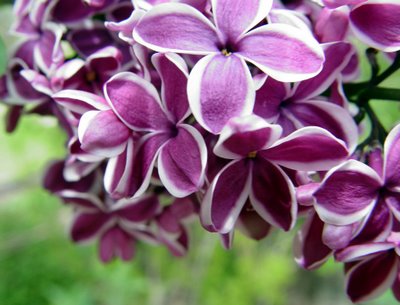
Spring has arrived, although the flowers are slow to share their smiling faces yet. As you plan your flower beds, keep in mind that many make a nice addition to table decor. Maybe it is time to add a variety of edible flowers to your spring garden.
Garnishing food with flowers makes such a pretty presentation at the table. Although guests may be startled at first, and uncertain if they should eat the flowers, it's fun to serve flowers with food. There's nothing prettier than a perfect miniature rose decorating a cupcake! They are so much prettier than the sugar ones!
Common edible flowers are violets, marigolds, nasturtiums, and chamomile. But, in addition to these old stand-bys, there are other flowers that also make a lovely presentation with food. Chrysanthemums, clover, dandelions, daylilies, roses, hyacinths, gladiolas, hollyhocks, impatiens, lilacs, and pansies are all blossoms that can be used in salads, to garnish dainty sandwiches, or to make a dessert prettier. Some blossoms of common herbs are make nice embellishments for food. The purple blossoms of chives are pretty fresh and retain their color when dried, thereby making a colorful presentation even during the winter months. Garlic, squash, and pea blossoms are also edible.
When selecting blossoms to be used with food, be sure to pick ones that have been grown organically. If they are purchased from a florist or garden center, the plants have probably been treated with pesticides and are not approved for food crops. Likewise, flowers picked along roadsides may have been sprayed with pesticide. Instead, grow your own flowers, purchase them at a grocer who carries flower blossoms (they are with the fresh herbs in the produce section), or choose flowers from meadows or woods that you know are safe to eat. Learn about flowers, so that you can correctly identify the safe ones. Some parts of some plants are edible, but will have other poisonous parts. This is even true with common garden produce (like rhubarb), so don't let that keep you from trying to 'good for you' parts of flowers.
Fresh flowers make beautiful garnish for desserts and look lovely tossed into a salad. But there are other ways to incorporate blossoms into food. Squash blossoms added to scrambled tofu is pretty. Squash blossoms also are beautiful when stuffed with a creamy filling mixed with chopped, fresh herbs. Nasturtium blossoms create a colorful filling for tea sandwiches, and rose or scented geranium blossoms can be used in cake batter or cookies. Chopped petals can be added to softened butters for spreads. And there is always floral tea! To make a blossom tea, add one tablespoon of petals per cup of boiling water and steep for ten minutes. Strain and enjoy with the herbal sweetener, stevia. Delicious!
So be brave! Try something new and see what kinds of flower power you can bring to your table! Have fun, be safe, and create to your hearts content!
Common edible flowers are violets, marigolds, nasturtiums, and chamomile. But, in addition to these old stand-bys, there are other flowers that also make a lovely presentation with food. Chrysanthemums, clover, dandelions, daylilies, roses, hyacinths, gladiolas, hollyhocks, impatiens, lilacs, and pansies are all blossoms that can be used in salads, to garnish dainty sandwiches, or to make a dessert prettier. Some blossoms of common herbs are make nice embellishments for food. The purple blossoms of chives are pretty fresh and retain their color when dried, thereby making a colorful presentation even during the winter months. Garlic, squash, and pea blossoms are also edible.
When selecting blossoms to be used with food, be sure to pick ones that have been grown organically. If they are purchased from a florist or garden center, the plants have probably been treated with pesticides and are not approved for food crops. Likewise, flowers picked along roadsides may have been sprayed with pesticide. Instead, grow your own flowers, purchase them at a grocer who carries flower blossoms (they are with the fresh herbs in the produce section), or choose flowers from meadows or woods that you know are safe to eat. Learn about flowers, so that you can correctly identify the safe ones. Some parts of some plants are edible, but will have other poisonous parts. This is even true with common garden produce (like rhubarb), so don't let that keep you from trying to 'good for you' parts of flowers.
Fresh flowers make beautiful garnish for desserts and look lovely tossed into a salad. But there are other ways to incorporate blossoms into food. Squash blossoms added to scrambled tofu is pretty. Squash blossoms also are beautiful when stuffed with a creamy filling mixed with chopped, fresh herbs. Nasturtium blossoms create a colorful filling for tea sandwiches, and rose or scented geranium blossoms can be used in cake batter or cookies. Chopped petals can be added to softened butters for spreads. And there is always floral tea! To make a blossom tea, add one tablespoon of petals per cup of boiling water and steep for ten minutes. Strain and enjoy with the herbal sweetener, stevia. Delicious!
So be brave! Try something new and see what kinds of flower power you can bring to your table! Have fun, be safe, and create to your hearts content!





